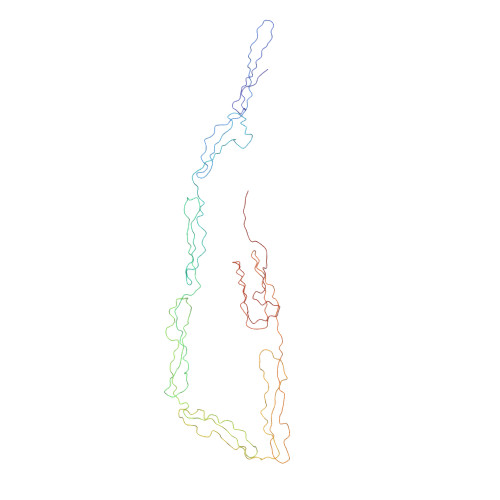The Dimeric and Trimeric Solution Structures of the Multidomain Complement Protein Properdin by X-Ray Scattering, Analytical Ultracentrifugation and Constrained Modelling.
Sun, Z., Reid, K.B.M., Perkins, S.J.(2004) J Mol Biol 343: 1327
- PubMed: 15491616
- DOI: https://doi.org/10.1016/j.jmb.2004.09.001
- Primary Citation of Related Structures:
1W0R, 1W0S - PubMed Abstract:
Properdin regulates the alternative pathway of the complement system of immune defence by stabilising the C3 convertase complex. It contains six thrombospondin repeat type I (TSR-1 to TSR-6) domains and an N-terminal domain. Properdin exists as either a dimer, trimer or tetramer. In order to determine the solution structure of multiple TSR domains, the molecular structures of dimeric and trimeric properdin were studied by X-ray scattering and analytical ultracentrifugation. Guinier analyses showed that the dimer and trimer have radii of gyration R(G) values of 7.5 nm and 10.3 nm, respectively, and cross-sectional radii of gyration R(XS) values of 1.3 nm and 1.5 nm, respectively. Distance distribution functions showed that the maximum lengths of the dimer and trimer were 25 nm and 30 nm, respectively. Analytical ultracentrifugation gave sedimentation coefficients of 5.1S and 5.2S for the dimer and trimer forms, respectively. Homology models for the TSR domains were constructed using the crystal structure of the TSP-2 and TSP-3 domains in human thrombospondin as templates. Properdin could be represented by seven TSR domains, not six as believed, since the crystal structure determined for TSP-2 and TSP-3 showed that the N-terminal domain (TSR-0) could be represented by a truncated TSR domain with the same six conserved Cys residues found in TSR-1 to TSR-6. Automated constrained molecular modelling revealed the solution conformations of multiple TSR domains in properdin at medium resolution. The comparison of 3125 systematically generated conformational models for the trimer with the X-ray data showed that good curve fits could be obtained by assuming that the linker between adjacent TSR domains possessed limited flexibility. Good trimer models correspond to partially collapsed triangular structures, and extended triangular shapes do not fit the data. The corresponding 3125 models for the dimer revealed a similar outcome in which a partially collapsed TSR structure gave good fits. The models account for the effect of mutations that cause properdin deficiencies, and suggest that the biologically active TSR-4, TSR-5 and TSR-6 domains are exposed for protein-protein interactions. The role of the other TSR domains in properdin may be to act as spacers to make TSR-4, TSR-5 and TSR-6 accessible for function.
Organizational Affiliation:
Department of Biochemistry, Darwin Building, University College London, Gower Street, London WC1E 6BT, UK.














